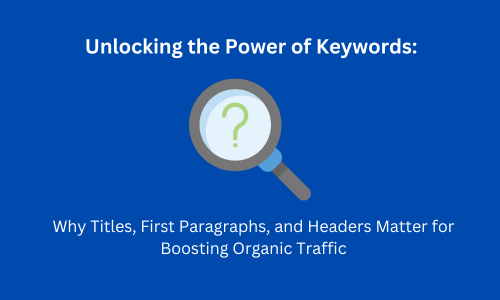

In the ever-evolving world of digital marketing, one constant remains crucial: the power of search engine optimization (SEO). For bloggers and content creators, understanding how to effectively use keywords can be the difference between a post that soars to the top of search results and one that languishes in obscurity. One key strategy is to strategically place keywords in the title, first paragraph, and headers. Here’s why this approach is essential and how you can make the most of it.
Keywords are the terms and phrases that users type into search engines when looking for information. For your blog to appear in search results, it needs to match these terms. Effective keyword usage helps search engines understand the topic of your content, which in turn improves your visibility and attracts targeted organic traffic.
Your blog title is often the first point of contact with potential readers—and search engines. A well-crafted title does more than grab attention; it also signals to search engines what your content is about.
1. Importance of Titles: Titles are crucial because they are the first thing users and search engines see. Search engines place significant weight on the words in your title, which influences rankings.
2. Best Practices for Keyword Placement:
The first paragraph of your blog post serves as the gateway to your content. It’s where readers decide if they want to continue reading, and it’s where search engines begin to assess relevance.
1. Initial Impressions: The first paragraph should clearly outline what the post is about. This helps readers quickly understand if the content meets their needs and encourages them to keep reading.
2. Keyword Placement Strategy:
Headers (H1, H2, H3, etc.) break up your content into digestible sections. They also play a crucial role in SEO.
1. Function of Headers: Headers help structure your content, making it easier for readers to scan and find the information they’re looking for. They also give search engines clues about the structure and main topics of your post.
2. SEO Benefits:
Avoid Keyword Stuffing: While keywords are important, overusing them can harm readability and result in penalties from search engines. Aim for a natural flow that prioritizes the reader’s experience.
LSI Keywords: Incorporate Latent Semantic Indexing (LSI) keywords—related terms that provide context and variety without repetitive keyword use.
User Experience: Always balance SEO with user experience. Content should be engaging and informative, ensuring that readers find value in what they’re reading.
To see if your keyword strategy is working, use tools like Google Analytics and Google Search Console. These tools can track how your keywords are performing and provide insights into traffic sources and user behaviour. Based on this data, adjust your strategy to continuously improve.
Inserting keywords into your titles, first paragraphs, and headers is a powerful strategy for enhancing your blog’s SEO and attracting targeted organic traffic. By following best practices and focusing on both search engines and user engagement, you can significantly improve your blog’s visibility and performance.
Implement these techniques, monitor your results, and watch your blog rise in search engine rankings. With a little attention to detail and strategic keyword placement, you can unlock the full potential of your content and drive meaningful traffic to your site.
Disclaimer: This article is provided for informational purposes only. It is not offered or intended to be used as legal, tax, investment, financial, or other advice.